Article written by Elisa - Travel Writer & Local in France
This article may contain compensated links. Please read disclaimer for more info.
Visit Carcassonne, France
The Cité de Carcassonne is one of our favorite places in France and will likely steal your heart too. Carcassonne is located in the region of Occitanie, in Southern France, between the cities of Toulouse and Narbonne.
The Cite de Carcassonne is a medieval citadel that contains the Carcassonne Castle, Saint Nazaire Basilica, and medieval houses. We have listed the Carcassonne Citadel as one of the most famous French landmarks and one of the top things to do in France.
One of the most visited cities in France, Carcassonne is a must-see destination for history lovers, French châteaux lovers, and those who want to enjoy a weekend in the sun in Southern France. Keep reading for the best things to do in Carcassonne, France, its history, how to visit Carcassonne Castle, and other travel tips.
Are you planning a Carcassonne trip last minute?
Below are some of the best Carcassonne tours, hotels, and more!
Book your train to Carcassonne. If you want to visit Carcassonne from Paris, you have direct connections by night train.
The Carcassonne Airport (CCF) is one of the most useful French airports in the region, connecting Carcassonne with many cities in England, Scotland, Belgium, Ireland, Denmark, and Portugal. A cost-effective shuttle allows travelers to get to the city center from the airport – Click here to buy your flight tickets to Carcassonne
There are many things to do near Carcassonne, and the region is best explored by car – Click here to rent a car in Carcassonne
Top Experiences and Tours in Carcassonne
- Carcassonne Castle and Ramparts skip-the-line tickets
- Cité de Carcassonne guided tour (small group)
- Carcassonne during World War 2
- Day trip to Carcassonne from Toulouse
Top Carcassonne Accommodation and Lodging
For your stay in Carcassonne, book at the hotel Mercure Carcassonne La Cité. This charming hotel comes with free private parking, and it has beautiful air-conditioned rooms and a garden, plus a swimming pool with fantastic views over the walled city.
Other good hotels in Carcassonne France are Hotel Astoria (budget), Hotel Montmorency & Spa (mid-range), Hotel l’ Aragon (mid-range), Hotel de la Cité & Spa MGallery (luxury), Hotel du Château & Spa Les Collectionneurs (luxury).
The Cité de Carcassonne is One of the Main Sites in the Cathar Country
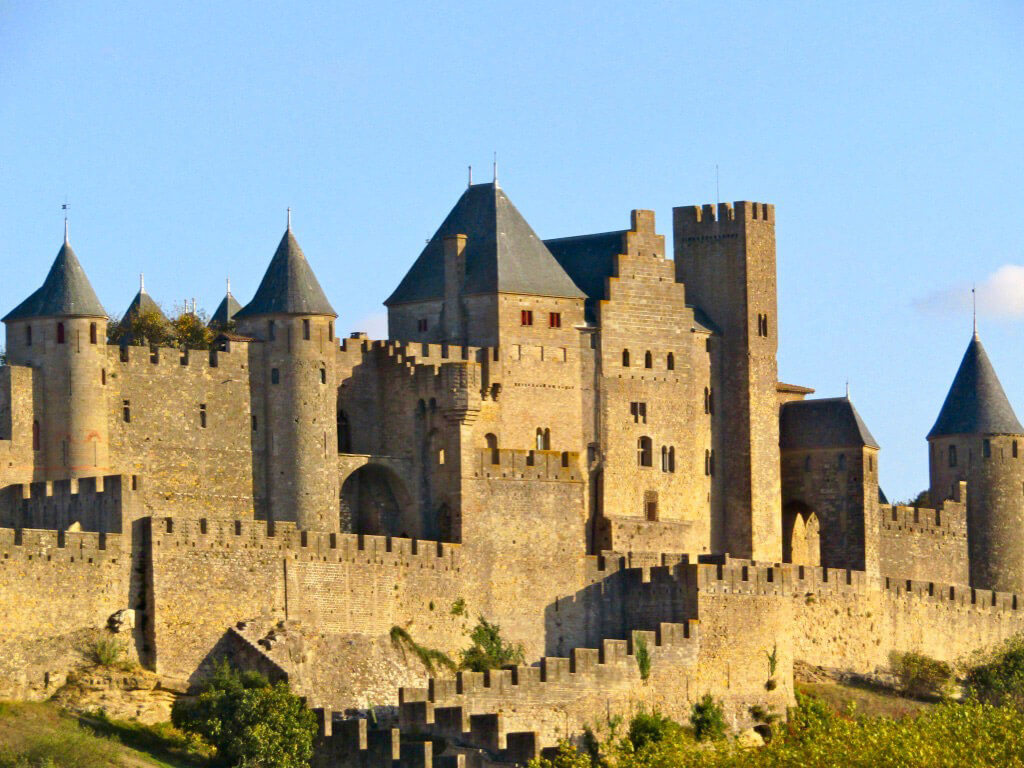
Carcassonne in France is one of the most important sites related to the Cathars in France. The Cathar religion had many followers within Carcassonne’s walls. Raimond-Roger Trencavel, Viscount of Carcassonne, protected the Cathars, and soon the city became a land of heresy in the eyes of the Catholic Church. When all the negotiations failed, Pope Innocent III launched a crusade against the Cathars.
The Castle of Carcassonne was one of the main targets during the first Cathar Crusade in 1209, which was led by Simon de Montfort. Carcassonne was besieged and surrendered in August 1209.
After the death of Raimond-Roger Trencavel, the Carcassone Citadel was occupied by the terrible Simon de Montfort, who turned the Carcassonne Castle into his headquarters to fight against the Cathars. You can see his tomb inside the Basilica of Saint Nazaire.
In 1226, the viscountcy of Carcassonne became part of the royal domain.
One of the top UNESCO World Heritage Sites in France, the Cité de Carcassonne is the perfect starting point for any road trip in the Cathar region of France. This 5-day Cathar Country road trip, which starts and finishes in Carcassonne, is one of the best road trips in France and covers the main Cathar sites in the region – Click here to rent a car in Carcassonne
Best Things to Do in Carcassonne, France
Here’s the list of the best things to do in Carcassonne, most of them inside the Carcassonne Citadel.
1. Learn the Story about Lady Carcas
The sculpture of Lady Carcas, at the citadel’s gate Porte Narbonnaise, reminds visitors of how Carcassonne got its name. Here’s the story:
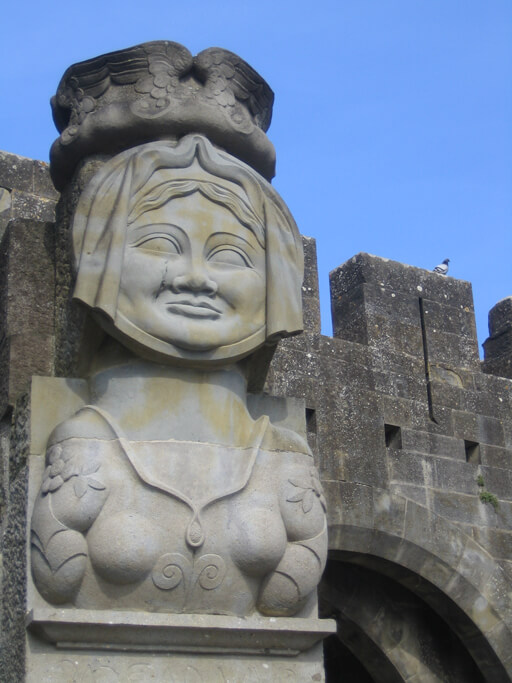
Some 1,200 years ago, the Saracen King Ballak ruled today’s Carcassonne when Charlemagne’s troops began the siege of this fortified town. The dry moat kept the enemy away, but during one of these assaults, King Ballak was mortally wounded, and his wife, Lady Carcas, assumed the role of leader.
The siege lasted for five years. Early in the sixth year, the Cité was running out of water and food. In one last attempt to save her people, Lady Carcas had the idea to feed a pig with one of the last sacks of wheat and then throw it from the highest tower of the city walls.
Believing that the city had enough food to the point of wasting pigs fed with wheat, Charlemagne lifted the siege and left. Happy with the success of her plan, Lady Carcas decided to ring all the bells in the city. One of Charlemagne’s men then exclaimed: ‘Carcas Sonne!’ which means ‘Carcas rings (the bells).’ Since then, the Cité has been named Carcassonne.
2. Visit Carcassonne Castle
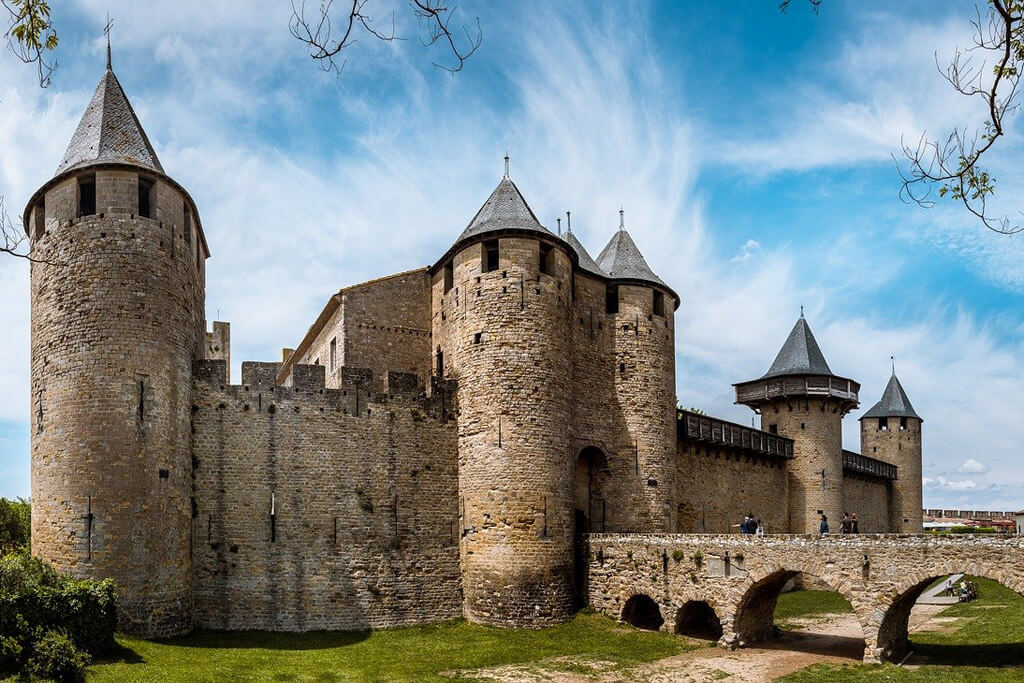
The stunning Château Comtal – or Count’s Castle – is a must-see inside the Cité de Carcassonne. The entrance is on the eastern side, and there’s an entrance fee to visit the castle – Click here to buy skip-the-line tickets
The Castle of Carcassonne is a medieval castle within the Cite de Carcassonne, a kind of fortress inside the fortress and one of the best castles in Southern France, the epitome of your fairytale medieval castle.
The Carcassonne Castle was built in the 12th century by Count Bernard Aton Trencavel over the western part of the Roman walls. It was surrounded by a rectangular fortified enclosure in 1226.
The construction is rectangular in shape, and it is separated from the city by a deep moat and defended by two barbicans.
The castle’s six towers are pierced with stirrup loopholes, and the curtain walls and the top of the towers can be used with hoists. The western flank of the walls, against which the Carcassonne Castle is built, is defended by a square watchtower – the Tour Pinte – the highest in the city.
Today, the castle’s walls support a reconstruction of hoardings between the door and the Major’s tower. The hoardings are the covered wooden walkways with openings that allowed soldiers to launch projectiles at invaders.


Inside the Carcassonne Castle, there are the remains of the Counts’ private chapel and a museum with an interesting collection of Cathar gravestones and other objects related to the Cathars.
3. Visit Basilique Saint Nazaire

This beautiful 10th-century building originally built in Romanesque style was the former Carcassonne’s Cathedral, consecrated by Pope Urbain in 1096. The current basilica has a Gothic style look, and it was completed in the first half of the 12th century but has been remodeled several times since then.
Saint Nazaire lost its cathedral status in 1801, replaced by Saint Michel Church in the lower city. It has the basilica status since 1898.


When we visited the basilica, some parts of the façade were under restoration, which allowed us to take some ‘Cathar pictures.’
Inside, you can see Simon de Montfort’s tomb and a beautiful collection of stained glass windows from the 13th and 14th centuries.
4. Walk along the Cité de Carcassonne Ramparts
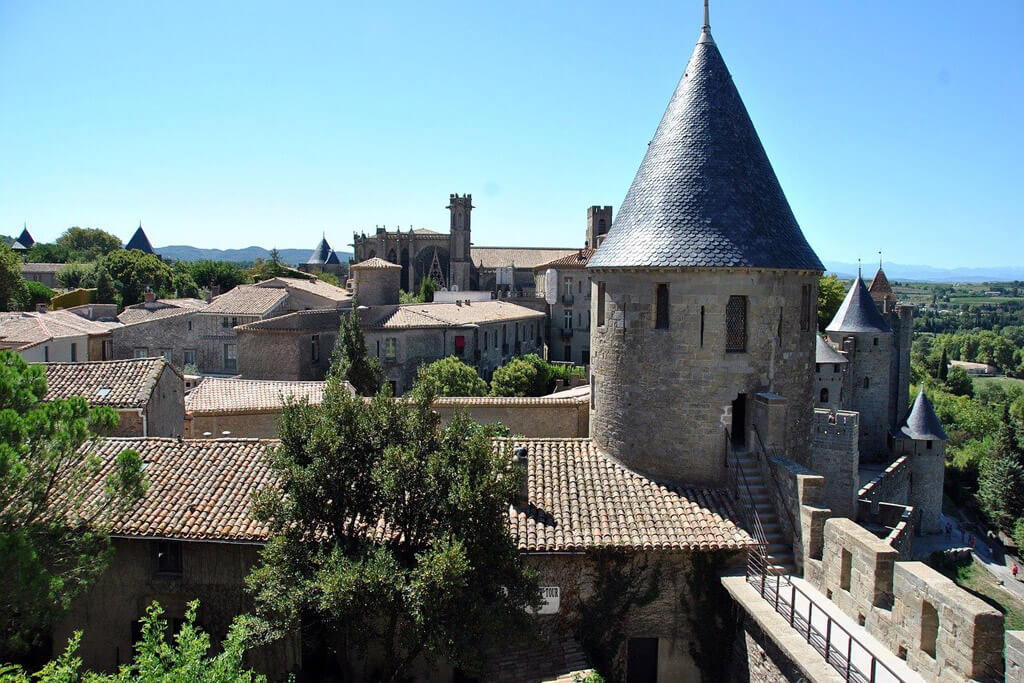
The imposing ramparts of the Cité de Carcassonne occupy a rocky outcrop that dominates the course of the Aude River. The Cité de Carcassonne dues its appearance with its pointed towers to Viollet le Duc, the French architect who, in the 19th century, (wrongly) restored the Cité following the patterns of the medieval villages and castles in Northern France.
The visit inside the Carcassonne Citadel is self-guided, and you can also walk along the walls. However, it is a good idea to take a guided tour with a knowledgeable guide to learn more about the Cathars and Carcassonne’s terrible past.
Walking along the Carcassonne ramparts is one of the absolute highlights of the Cité de Carcassonne. These stunning walls are witness to 1,000 years of military architecture and 2,600 years of history, plus the views from the ramparts are spectacular.
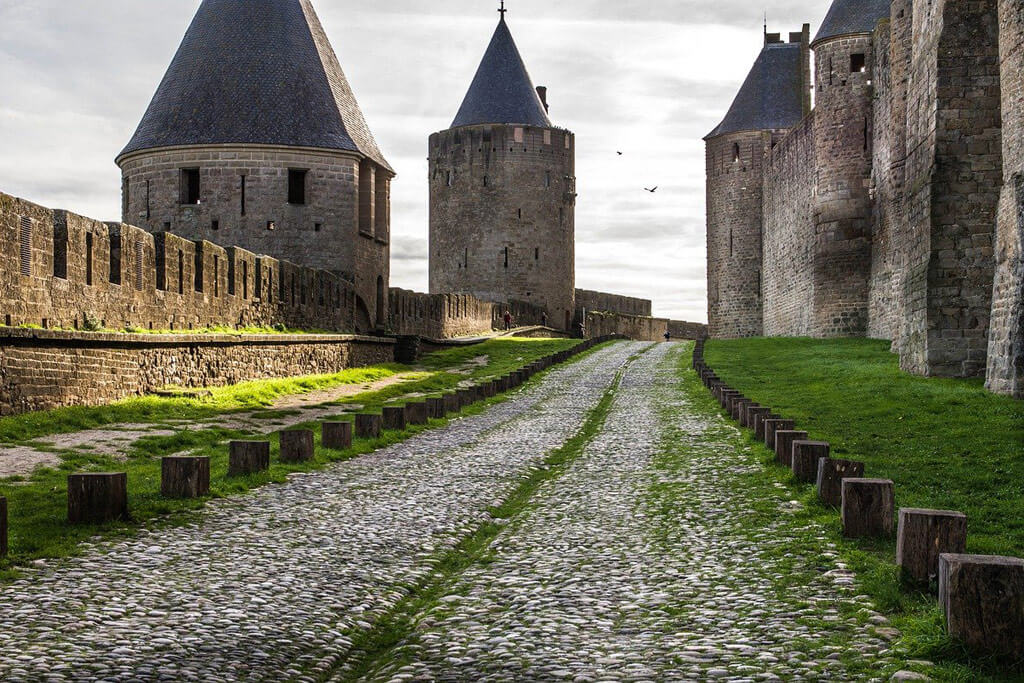
The Carcassonne ramparts are punctuated with 52 guard towers. Some of them are simple stone structures accessed by low arched doorways on each side. Others are grand architectural constructions with multiple floors you can explore. One of the towers even housed the Catholic Inquisition in the 1200s! Inside this tower, the architect Viollet-Le-Duc found about 200 skeletons during the restoration works.
5. Stroll around the Carcassonne Citadel

The medieval Carcassonne Citadel, which is in the southeastern corner of today’s Carcassonne, is a lovely place for a stroll, with winding cobbled streets, picturesque squares with stone fountains, and a homogeneous medieval architecture.
Apart from the Carcassonne Castle and Basilica, there are two museums (Musée de l’ Inquisition and Centre d’Histoire Vivante Médiévale), many hotels, restaurants, and souvenir shops. Although it is a touristy place, the Cité de Carcassonne has managed to keep its authentic atmosphere and a particular charm.
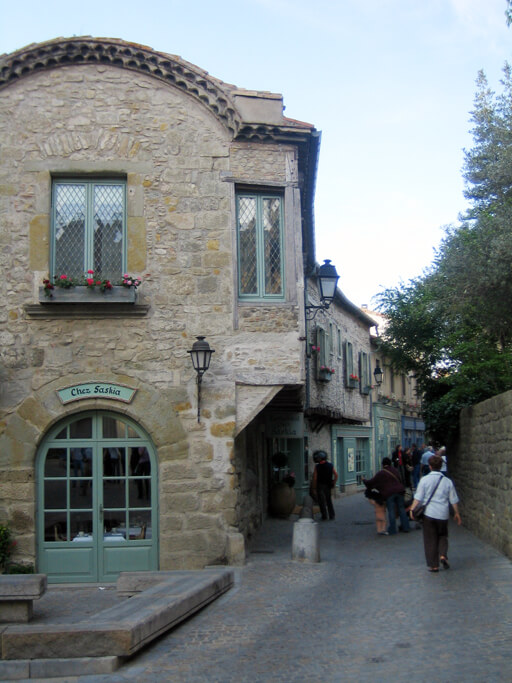

The Carcassonne Citadel has four entrances:
- Porte du Bourg – Rodez Gate to the north
- Porte Narbonnaise – Narbonne Gate to the east
- Porte Saint-Nazaire – Saint-Nazaire Gate to the south
- Porte d’Aude – Aude Gate to the west
6. Visit Carcassonne’s Lower City (Bastida Saint Louis)

The Lower City, built after the siege, is also interesting to visit. Named Bastida Saint Louis, this newer part of Carcassonne has a completely different design known as “bastida.”
In the Languedoc region, “bastida” designates a village or a town built on a regular plan, giving it its specificity. The bastides were built between the Albigensian Crusade and the Hundred Years’ War in the 13th and 14th centuries. Generally, the bastides are constructions a Novo sine populated, but their establishment is not necessarily carried out on virgin territory. Today, we count around 500 bastides in Southern France, like the lower city of Carcassonne or the lovely town of Mirepoix.
In addition to the medieval bridge and Saint-Michel Cathedral, the Bastida Saint Louis has some interesting buildings worth the visit, and Place Carnot is a lovely place to hang around.
So, what are you waiting for? Book your trip to the Cité de Carcassonne today!
